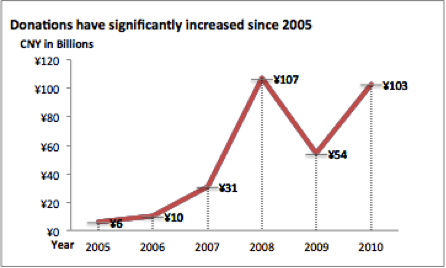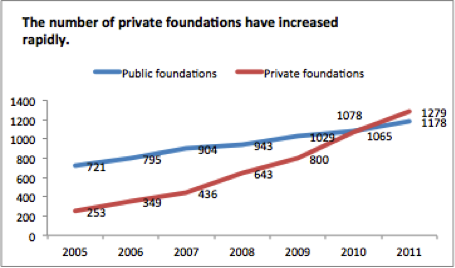04 Nov 2012
An Overview of Chinese Philanthropy
The economic performance of China in the last 30 years has been remarkable, but the Chinese government is finding itself in a challenging position. Largely due to the economic growth, demands for public goods have increased. The government has realized it simply can’t provide adequate public goods and services and it needs to mobilize all possible resources; increasing income disparities, widening urban-rural divide and growing inequality in access to educational opportunities may lead to social unrest; citizens are more economically independent, educated and resourceful than they were 30 years ago, with growing means to engage and even confront the state. These are the challenges the government can’t ignore, because they will not only hinder economic development, but also arouse social turbulence, which will endanger the power of the state.
[break]
Philanthropy is aimed at addressing social problems, which aligns with the priority of the government. As a result, government is gradually loosening control over philanthropic sector to encourage more individuals and organizations to take on some of the burdens of providing social services. Meanwhile, the economic prosperity in the past 30 years has created a significant amount of private capital, and philanthropy offers a platform for people to give back to society and to fulfill their social responsibility. These two factors have played important roles in the development of philanthropic sector, and will continue to provide impetus for philanthropy to grow.
[break]
Like many other terms with “Chinese characteristics”, “Philanthropy” is not well-defined in China, and often interchangeably used with NGOs. Currently, the Chinese philanthropic sector is mostly comprised of the following entities[1]:
[break]
- Public foundations: foundations that are allowed to raise funds from public; almost all public foundations are GONGOs[2], except a few independent foundations, such as Amity Foundation in NanJing, The One Foundation in Shenzhen, and RenDe Foundation in Shanghai.
- Private foundations[3]: foundations that are not allowed to raise funds from public, including corporate foundations, university foundations and foundations established by individuals.
- Corporate donors and individual donors
[break]
The growth in the Chinese philanthropic sector can be marked by the rapid increase in the amount of donations in the last few years. The sharp increase in 2008 and 2010 was caused by the catastrophic disaster in Sichuan and QingHai. Even if taking out emergency relief, we can still observe a pattern of significant increase in donations. (Figure 1) The growth is also reflected by the increase in the numbers of private foundations. Private foundations were not allowed to exist until 2005, but have burgeoned since then. They outnumbered public foundations within 5 years. (Figure 2) The growth is expected to continue.
[break]
Figure 1: Donations have significantly increased since 2005.
Source: The China Charity Information and Donation Center
[break]
Figure 2: The number of private foundations has increased rapidly.
Source: 2011 China Private Foundation Development Report
[break]
The numbers clearly demonstrate how fast the Chinese philanthropic sector has grown. At the same time, the optimism toward the future of Chinese philanthropy can be better grounded in observing some emerging trends in the field.
- Since 2008, the government has publicly promoted philanthropy in different occasions, including party conferences. A chapter on developing philanthropy was included in the government’s 12th 5-year plan for 2011-2015. Experiments are being carried out at local levels on adopting more flexible policies on registration, access to public fundraising etc. If successful, these experimental policies are likely to be scaled at a national level.
- A group of foundation leaders, mostly from private foundations, have committed to increasing transparency, accountability and professionalism in the philanthropy sector[4] through a range of efforts, such as making strategic shift from operating foundations to grantmaking foundations, voluntarily disclose program and financial report, directing more support to grassroots nonprofit etc.
- Nonprofit organizations are becoming more responsive and mature. Some of them have developed more positive dynamics with government and foundations.
- Collaborations have been forged to advance the field. Some foundations, both public and private, have increasingly worked together in collective funding and even challenging some government regulations. The launching of China Foundation Center is the result of a collaboration from 18 foundations. Annual Private Foundations Forum has been a sector-wise gathering to share knowledge and lessons.
- Citizen participation has surged since the SiChuan earthquake in 2008. Philanthropy and nonprofit have received more media coverage. Several newspapers and magazines specialized in philanthropy have come out. Major portal webs all have a section dedicated to philanthropy and nonprofit.
[break]
Despite the bright pictures, the road ahead won’t be smooth.
- The legal structure and the tax system are still not fully supportive to philanthropic sector yet. Regulations concerning taxation on investment income and mandatory payout rate are considered major impediments to foundation growth.
- The privileges GONGOs enjoy in public fundraising haven’t delivered better services. Instead, such privileges have brought about a lot of bureaucracy and even corruptions. Several mass GONGOs, such as China Red Cross Society, Song Qing Ling Foundation, became the epicenter of scandals in 2011, which have seriously hurt the credibility of organizations involved and the whole sector. Final statistics are not available yet, but donations in 2011 are expected to plummet as a result of [decreasing] public trust.
- The accountability and effectiveness of both foundations and nonprofit organizations present serious bottleneck for development of philanthropic sectors. At the same time, the rapid growth in foundations has already demonstrated a huge talent gap, in terms of both numbers of professionals and quality of foundation workforce.
[break]
Putting Chinese philanthropy in a comparative context with American philanthropy, we can see there’s still huge room for Chinese philanthropy to grow:
- Even with the increased donations in recent years, total amount of donation in 2010 only accounts for 0.17% of GDP, while that amount is 2% in the U.S.
- The United States has about one foundation per 3,000 people, while China only has one foundation per 650,000 people[5].
- The potential of individual donation remains untapped. The latest World Giving Index 2011 ranked China at the 140th place in a pool of 153 countries among the world, with 14% of the population giving money, 4% volunteering time, and 44% helping a stranger, compared with U.S. in the 1st place, where the numbers are 65%, 43% and 73% respectively.[6]
[break]
In summary, Chinese philanthropy has grown rapidly in size and in scale in the last few years, but substantial challenges exist, and some big questions remain unanswered.
[break]
Government’s inability to provide adequate social services leaves ample room for philanthropy to operate, but the fledging sector has put most resources to “charities”, and hasn’t seemed to fully embrace the independent, flexible and risk-taking power of philanthropic capital yet. Should philanthropy evolve into a service provider to fill the void left by government or should philanthropy play a more profound role in the society, e.g. support innovation, advance civil society, etc.? Meanwhile, as many global problems have crossed boarders and as China is becoming an increasingly important player in the world, what role should Chinese philanthropy play in the globe? How should Chinese philanthropy fit into the scene of global philanthropy? In my opinion, the answers to these questions will to a great extent determine how far Chinese philanthropy can go.
[1] Dr.Shawn Shieh, English-language Editor at China Development Brief, gives a good account on Chinese nonprofit and philanthropic sector in New Trends in Philanthropy and Civil Society in China, Summer Issue. It can be downloaded at http://www.cdb.org.cn/userfiles/Special%20Issue-2011-Summer.pdf
[6] World Giving Index, a Global View of Giving Trends, Charities Aid Foundation, 2011





